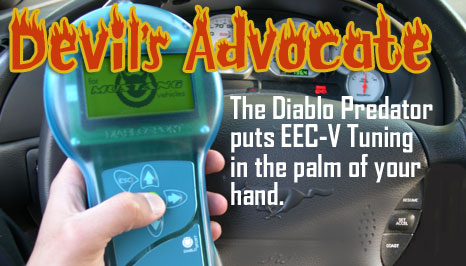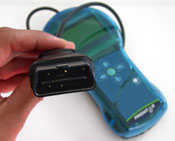|

It is funny to think that twenty years
ago, when Ford Mustangs were introduced with computer controlled
engine systems, many people felt it signified the end of hot
rodding. "EFI and EEC controlled engines will be too complicated
for the lay person to modify",
the nay sayers lamented. Obviously time has proven them wrong,
and late-model Mustangs have become some of the most modified
vehicles on the planet. While there is no denying that today's
vehicles do indeed have more complex engine systems, the aftermarket
companies have stepped up and created modern tools to make tuning
and modifying a cinch.
One such class of modern tools is the handheld tuner. If electronic
tuning devices were subject to evolution then the handheld tuner
is to the performance "chip" as humans are to chimps.
When the 5.0L Mustang came out with it's EEC-IV processor companies
responded to the need for modifying the factory parameters by
creating piggy-back chips which plugged into the service port
on the EEC-IV processor. The chip held modified parameters to
affect air-fuel ratio, idle speed, and other engine functions.
While chips helped many owners of wild engine combinations solve
their tuning issues, they were limited in their flexibility.
For one, the chip had to be burned by someone with the appropriate
know-how and burning software. Secondly, because chips held
custom "one off" tunes, you typically had to get on
a dyno so the chip tuner could make changes while seeing the
effects. A custom burned chip would likely end up costing you
$600 or more once you add up the dyno time, chip tuners time
and chip cost. To add insult to injury if you made a subsequent
modification to the engine, such as change a manifold or throttle
body, you'd have to get the chip reburned.
Bring on OBD II
That was the Mesozoic era. In 1994 the Feds mandated all vehicles
sold in the US beginning in 1996 were required to have OBD-II,
or On Board Diagnostics System second generation. OBD-II is
a standard for emissions systems monitoring. Since virtually
all of a vehicles engine and

The Predator writes and reads the
vehicles PCM data via the standard OBD-II port. Every
vehicle from 1996 onward uses this diagnostics protocol.
The Predator writes, or "flashes" files to the
Ford EEC-V processor via this connector. |
driveline systems can potentially
impact emissions the OBD-II system is a quite complex electronic
integration between the vehicles PCM (powertrain control module),
sensors, and dash display. The OBD-II system can detect and
display a trouble code for engine components and systems failing
or about to fail. OBD-II also mandates a standard 16 pin diagnostic
port, or DLC (diagnostic link connector) where technicians can
plug in a scan tool to monitor virtually every sensor on the
vehicle. Besides diagnostics
the other benefit to the OBD-II standard is that many PCM's
(such as Ford's EEC-V) can be reprogrammed, or "flashed",
through the OBD-II port. Flashing or programming requires a
device which contains flashing software/firmware and either
stored programs, or a human interface to allow parameter modification.
Enter the Diablo Predator.
While certainly not the only handheld tuner on the market, the
Predator might however be the most versatile. The unit appears
as a typical scan or code-reader tool. In fact while it does
indeed scan diagnostic trouble codes the real brawn is in it's
ability to put a performance tune into your Mustangs brain.
Note that while this article features testing of the Predator
on a Mustang, the unit is also available for a wide range of
Ford performance cars and trucks, including the Mercury Marauder,
SVT Focus, F-series trucks and Powerstroke diesels. The
units comes prepackaged with a Diablo engineered tune for that
specific make and model vehicle. The unit's DLC connector is
attached to the vehicles OBD-II port (typically located 16"
from the steering wheel under the dash or near the center console).
Once connected the unit powers up and the on screen display
provides instructions for loading up the performance tune, backing
up the stock tune, and making additional modifications.
The Predator provides several options. The first is to load
up the tune provided by Diablosport. Like many tuning companies
they have done their homework on a stock Mustang, or whatever
vehicle the unit was purchased for, and come up with a canned
program that will result in some increase in performance over
stock. This generally boils down to air-fuel ratio and timing
changes, and the amount gained usually depends on how much slack
the factory left in the stock tune.
When the unit is connected to a vehicle for the first time it
"marries" itself to that vehicles VIN number and creates
a backup of the factory settings. Then the owner is free to
load up the supplied tune, modify the stock settings and effectively
create their own tune, or to modify the supplied tune. The Predator
enables tuning wide-open throttle air-fuel ratios to a certain
percentage leaner or richer than stock, in two rpm ranges; 2000
to 4000 rpm and 4000 to 7000 rpm. Timing can also be advanced
or retarded for those two wide-open throttle ranges. A host
of other very useful parameters are modifiable. RPM and speed
limits can be adjusted. For automatic transmissions the torque
firmness and modulation can be set adjusted for all gears. There
are also several emissions related settings, such as turning
off the EGR or downstream O2 sensors, for vehicles using off-road
components. A nice feature is if you have modified your differential
gear ratio, or installed different height tires, you can use
the Predator to program the correct speedometer differential.
With capabilities such as this the $400 unit begins to pay for
itself when you consider the savings from having to spend on
external speed calibrator devices, or O2 sensor MIL eliminators.
Installing and Testing
On our test vehicle, a 2001 Mustang GT, we loaded up the supplied
Diablo performance tune, version v.7r50c. Diablo's website
maintains a list of updated tunes, so it is wise to check it
often for new and improved files. Using a serial cable
the Predator can also be connected to a PC for downloading new
tunes into the unit, or uploading the backup tune and on your
laptop or desktop. The Predator also has a live data view and
logging utility which is useful to see actual engine sensor
data. The log can be transferred to a PC for viewing with free
software available from Diablosports website.
Once the Predator writes the tune to your vehicles PCM, a process
which takes several minutes, the unit can be disconnected. The
tune is now permanently in your engines computer and can only
be removed by the same Predator unit which installed it. The
Predator unit cannot be used on another vehicle until it has
restored the factory tune to the vehicle from which it was backed
up. Once the new tune is written to the vehicle you can opt
to make additional changes, or fine tuning.
|
| |

(Dyno Results) |
|
|
|
|
|
|
|

